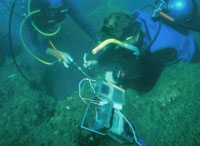 |
|
Maritime
Lanka Hercules 1661: • site Galle Research Subject index Image archive What's new People/contacts L |
23 Dec 2001
|
|||
| Last modified: 23 Dec 2001 |
 After
the 1992 expedition, a conservation management plan examined a number of options
including in situ protection, recovery of cannon, and burial. These possibilities
may be of interest for other cannon sites, so we will summarise them here.
After
the 1992 expedition, a conservation management plan examined a number of options
including in situ protection, recovery of cannon, and burial. These possibilities
may be of interest for other cannon sites, so we will summarise them here.
Wave action is significant on the site, often enough to toss a diver several metres in each direction and make it hard to manage a tape measure, and the water movement must be much greater during the monsoon season. Most of the cannon are fully exposed to the water movement, as at various angles they lie between or rest on top of boulders. The specific location of each cannon and the degree of protection afforded by intervening boulders will determine how each is affected. The environmental influences are as follows:
Surge: the surge generated by the swell exerts lateral forces, particularly on those cannon which lie across the direction of swell.
Turbulence: in the turbulent, aerated surf zone, the sea water has a relatively high oxygen content. Physical damage and corrosion are likely to be accelerated in this zone.
Attrition: the movement of large substrate materials, such as the smaller boulders, may cause damage.
Erosion: coarse abrasive sands and small stones can cause erosion, inhibiting the formation and/or maintenance of protective concretion layers and thus accerating corrosion.
Currents: the diving team has experienced only slight currents on this site, but stronger flows may contribute to erosion.
Tidal influence: the half-metre tidal range for Galle probably has little influence, as none of the cannon would become exposed to the air. However, wave-generated forces on the cannon in shallow water are likely to be greater at low tide.
Marine growth: corrosion can be reduced if hard corals or other marine growths colonise the surface of a concretion, reducing its porosity. The Hercules cannon concretions have little marine encrustation.
Three of the cannon are badly eroded, with significant material loss. To protect them from further erosion, they could be moved to an alternative location on the site - either mid-site, where they would be protected amongst the boulders, or, preferably, buried in the sand near the five cannon in deeper water. Burial would provide the cannon with a less aggressive environment, allowing concretion to form on exposed surfaces. Naturally, positions should be carefully recorded and corrosion data collected before removal. If the cannon are buried, this should be to a depth where the sand appears stable, and not subject to disturbance, otherwise the move could be counter-productive.
Recovering individual cannon may be attractive, for onshore analysis and display. With the exception of those cannon damaged by erosion, the Hercules cannon formed concretions which have served to protect the soft graphitized surfaces of the corroded cannon. We would expect surface markings, such as inscriptions, to have been retained in the graphitized surface.
The eroded cannon revealed substantial metal, despite having experienced severe corrosion. Should the decision be made to recover a cannon, the more seaward ones are likely to have better preserved surface detail and retain more residual metal, because it is assumed that the higher oxygen content of aerated turbulent waters will have accelerated corrosion. Less graphitization means less salt retention, and consequently reduces the treatment time required.
During active service, cannon were sealed with a wooden tampion or plug to prevent water spoiling the charge. It is possible that some of the Hercules cannon remain sealed following their loss in the sea. If the tampion is quickly concreted over by the iron corrosion process, the charge can survive. It is not unusual to find the wadding, ball, and bag of powder inside. This possibility could be investigated in situ as it may influence the recovery decision.
Following pH and corrosion measurements of iron objects, individual items may be provided with galvanic protection by connecting sacrificial anodes. The anodes may be purpose-made of zinc, or alternatively of scrap aluminium (eg engine or gearbox casings). These are connected by heavy duty cable (battery cable), and clamped to the artefact. This achieves two things: corrosion is pacified, and the strength of the corroded surface is improved. If an anode is connected to an iron artefact in sea water, the harmful chlorides are released, and stabilization begins in situ. This reduces the treatment period required after recovery.
Corrosion potentials (E.corr: the measurement of voltage produced during corrosion activity with respect to a known reference voltage) and the extent of graphitization (corrosion) enable a prediction to be made as to the life of the residual metal core, and make an informed decision on the best course of action. A completely graphitized cannon will have lost the strength of the iron and must rely on the reinforcement of the encapsulating concretion; it may not in the long term be able to withstand the physical stresses of severe weather conditions.
The acquisition of environmental pH and E.corr data from cannon at this site would add significantly to our understanding of the corrosive processes occurring in cast iron in the marine environment. So far this work has only been undertaken within Australia. This tropical-water site offers a collection of large iron objects consistent in type and of similar dimensions and materials. Analysis can reveal the micro-environment under the concretions, and hence shed light on the corrosive process and how it differs for cannon in the various locations and orientations.
| Maritime Lanka homepage | Galle index |